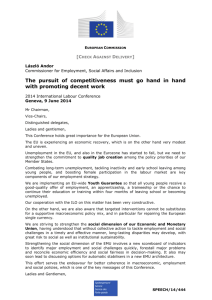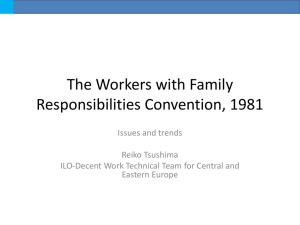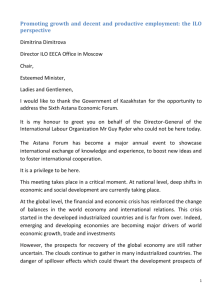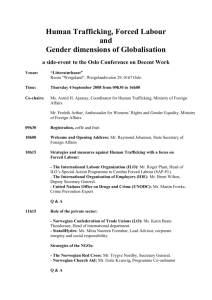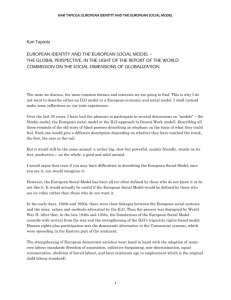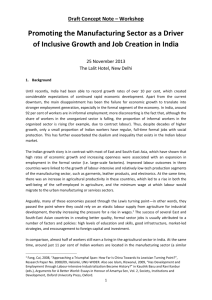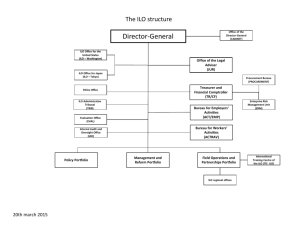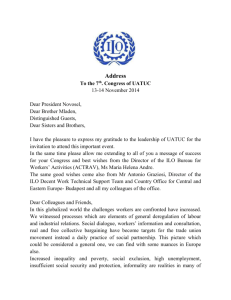Involuntary temporary employment
advertisement
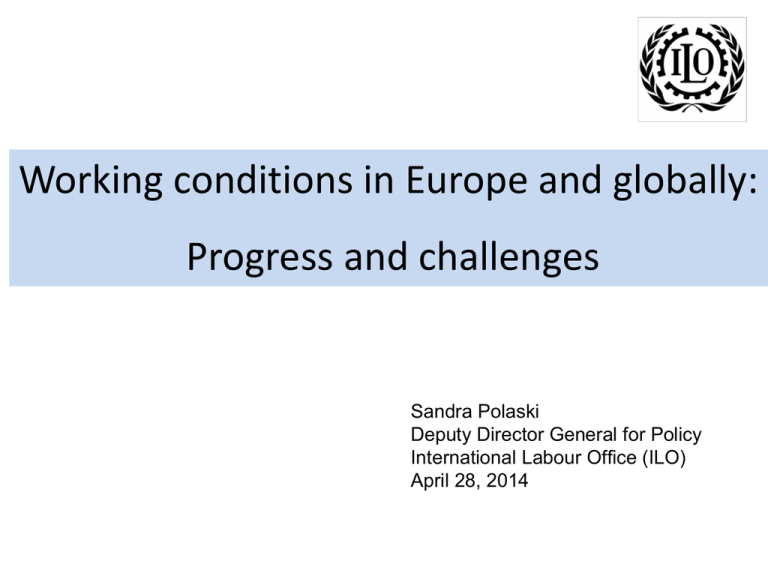
Working conditions in Europe and globally: Progress and challenges Sandra Polaski Deputy Director General for Policy International Labour Office (ILO) April 28, 2014 Steadily falling workplace accident rates in Europe, but faster increase in work-related health problems Serious injuries at work (>3 days’ absence) index, EU27 Work-related health problems (% of persons that work or worked previously): 9 EU countries 120 100 80 8 6 60 4 2 40 0 1999 20 0 2000 2001 2002 Source: EUROSTAT 2003 2004 2005 2006 2007 Involuntary temporary and part-time employment Involuntary temporary employment (% of total temporary employment) Involuntary part-time employment (% of total part-time employment) 2000 2008 2010 2012 2000 2008 2010 2012 53.7 59.7 61.7 60.8 18 25.3 26.7 27.7 Greece 84 82.5 84.9 86.4 48.4 44.1 54.7 65 Ireland 34.1 40.8 62.8 67.7 17 13 32.5 41.2 Italy 52.3 64.6 67.8 71.2 38.1 41.5 50.5 58.8 Portugal 44.1 81.9 84.2 87.2 31.7 40.8 43 47.9 Spain 93.5 87.3 91.5 91.9 23.7 35.4 49.3 60.9 EU27 Source: ILO Research Department based on Eurostat Countries with more apprenticeships have lower youth unemployment Youth Unemployment 10 year avg 30 25 Italy 20 France Canada 15 UK US 10 Australia Germany Denmark 5 Austria Switzerland 0 0 5 10 15 20 25 30 35 40 45 Apprentices per 1000 employed Sources: The State of Apprenticeship in 2010: Australia, Austria, England, France, Germany, Ireland, Sweden, Switzerland Report commissioned by the Apprenticeship Ambassadors Network, Centre for Economic Performance, London School of Economics and Political Science Special Report, 2010, and http://cep.lse.ac.uk/pubs/download/special/cepsp22.pdf; Apprenticeship Participation by Age 2009/10: Australia, Austria, England, France, Germany, Switzerland:An Update on ‘State of Apprenticeship’ September 2010 December 2011 Apprenticeship AmbassadorsNetworkhttp://www.apprenticeships.org.uk/~/media/AAN/Documents2/AAN-StateofApprenticeship2010Update.ashx; Possible futures for the Indian Apprenticeships system’ project: Canada, Indonesia, Turkey and United States ILO and University of Ballarat; UNESCO Institute for Statistics: http://www.uis.unesco.org/Education/Pages/default.aspx, retrieved 18.08.2012. http://www.lavoro.gov.it/NR/rdonlyres/49C26BEA-9E14-408F-A304B54DD7DE826B/0/XIIRapportodiMonitoraggioApprendistato.pdf; ILO Statistics for youth unemployment data (1999-2008). 50 Progress on child labour around the world Source: ILO (2013): Marking progress against child labour: global estimates and trends 2000-2012 5 Organization of work into global supply chains Over recent decades, work in many sectors has been reorganized into global supply chains that distribute different stages of production to many countries. This has been positive in creating new employment opportunities in many developing countries where they are needed to lift people out of poverty and foster inclusive development. However it has eroded the impact of good labour laws, enforcement and social dialogue institutions in many countries where they had been developed and effectively operated for decades. The Better Work Program A pioneering ILO initiative to promote collaboration across supply chains to improve working conditions and foster growth of enterprises and employment. Created in Cambodia in 2001. Now operates in 7 countries and about to launch in Bangladesh. Now a collaboration with the International Finance Corporation arm of the World Bank. Financed primarily by extra-budgetary donor funds and revenue from charges for services provided to factories and global buyers. The EC as recently joined as a contributor. The Better Work Program: How it Works Better Work monitors factories in the garment sector and reports on compliance with international labour standards and national labour laws. In some countries the reporting is completely transparent, with individual factory performance reported on the internet. Better Work teams advise and build the capacity of employers and workers to improve compliance and productivity. All Better Work country programs operate with a tripartite committee of government, workers’ and employers’ organizations and with bilateral committees at factory level to jointly address problems or deficiencies. The EU Sustainability Compact with Bangladesh The “Compact for Continuous Improvements in Labour Rights and Factory Safety in the Ready-Made Garment and Knitwear Industry in Bangladesh” was agreed last May after a series of workplace disasters in that country by Foreign Minister of Bangladesh and the EU Trade Commissioner. Commits the parties to time-bound actions, including reform of the Bangladesh Labour Law to strengthen workers’ rights; assessing building and fire safety in all garment factories by June 2014; and recruiting 200 additional inspectors. ILO acts in a monitoring role to follow up on commitments. Number of free trade agreements that include social and labour provisions 70 60 50 24 40 17 Conditional 30 Promotional 20 7 34 27 10 2 14 0 1990 1 3 9 1995 2000 2005 2010 2013 Source: ILO (2013), Social dimensions of free trade agreements Working conditions in Europe and globally: Progress, challenges and next steps • In Europe, most are satisfied with their jobs, but many are left behind, including some entire countries. • An ambitious effort by the EC is called for to address those left behind. • Globally, there has been great progress on poverty and child labor. • But many workers in supply chains continue to subsist on poverty wages and in poor working conditions. • Global efforts through technical cooperation, supply chains and trade have promise that should be extended and utilized.
